Most veggies don’t last long in storage and cauliflower is one of them. If you end up with more cauliflower than you can use before it goes bad, that’s the time when you look for ways to preserve it.
When it comes to preserving food, freezing is the undisputed king. Almost everyone has a freezer and prepping food for freezing doesn’t require fancy equipment. Can you freeze cauliflower? Sure you can and the process is fairly simple. In this article we will go through preparing, freezing and defrosting this vegetable. Sounds interesting? Read on.
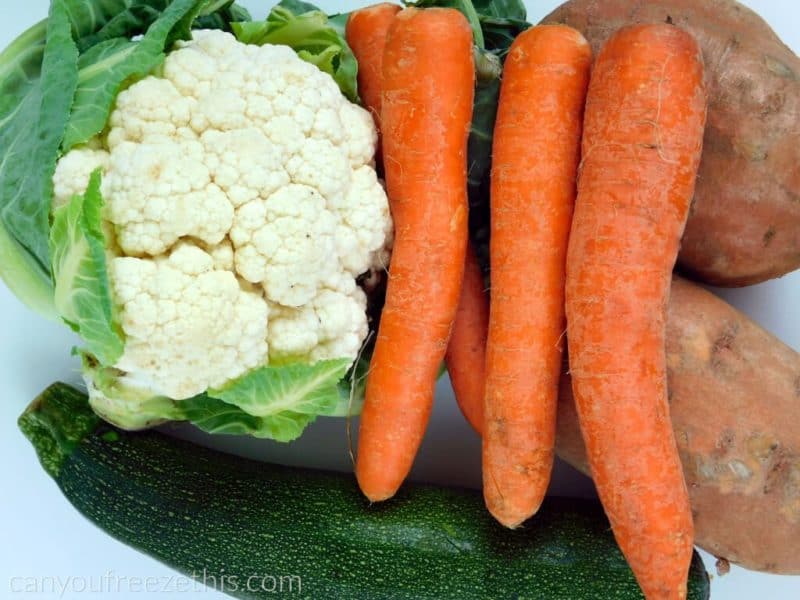
Choosing and Preparing the Cauliflower
To get great frozen cauliflower (and any other vegetable), we need to start with good produce. When buying cauliflowers, pick the best ones available. They should be free of any spots or blemishes or have only a few small ones. The florets should be firm and tight.
Once we have our veggie ready, start removing the leaves. Washing is the next step. Rinse it thoroughly under running water. If the cauliflower head is a large one, consider cutting it into smaller pieces for easier washing. Make sure water runs through all the crevices and all the dirt is removed. Similarly to broccoli, if you’re worried about bugs, soak the cauliflower in salty water for half an hour. That will kill the bugs and most of them will end up in the bottom of the bowl. After soaking, wash the vegetable.
Once cauliflower is washed, it’s time to cut it into florets. Consider how you will use the florets in the future and choose floret size that the makes most sense for that purpose. If you’re unsure, go for smaller florets. With smaller florets, cutting will take more time but they are more versatile to use and defrost. Smaller florets cook quicker too. Now that you have cauliflower florets ready, it’s time to choose the freezing method.
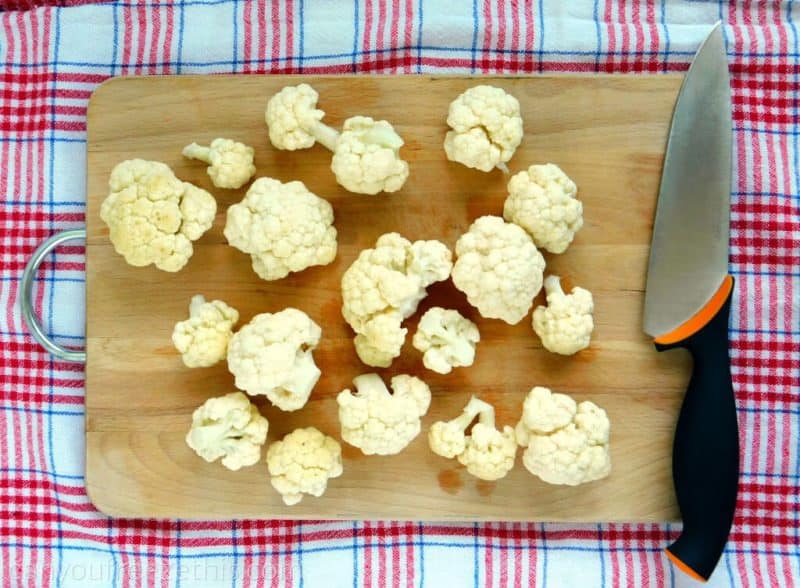
How to Freeze Blanched Cauliflower
Blanching is used for freezing many vegetables. It helps retain the veggies’ color, shape, and firmness after defrosting. You can skip this step, but the thawed cauliflower will often be discolored and mushy. Here’s the step by step process for this method of freezing:
- (Recommended) Blanching. To blanch, bring a large pot of water to a boil and cook the cauliflower in the boiling water for 2-3 minutes, depending on the floret size. If you are blanching a lot of cauliflower florets, do this in batches. Just be sure to bring the water back to boiling each time. Once the florets are done, transfer them directly into an ice bath (cold water + ice cubes) to stop the cooking process. Allow the cauliflower to sit in the ice bath for three minutes, then discard the water. Check out our article about freezing blanched broccoli to learn more about this method.
- Pat the cauliflower florets dry. Before you put the florets into the freezer, you should remove as much water as you can. I usually let the florets sit a in a colander for a few minutes, then transfer them onto a dish towel for half an hour. After that, I use another dish towel or a paper towel to get the remaining drops of water. Don’t be lazy with this part. If you’ll freeze wet florets, they’ll freeze in clumps with ice and that’s definitely not what you want.
- Portion the veggie. Consider how much cauliflower florets you will need at a time. That’s your portion for freezing. If you’re not sure, it’s better to divide the florets into many smaller portions instead of a few large ones. This way you can defrost as much as you need at a time.
- Transfer the cauliflower into freezer bags or containers. If using freezer bags, squeeze as much air out of the bag as possible before you seal it. Using a drinking straw to get the remaining air out of an almost sealed bag is a nice trick to help you with that.
- Label the bags with name and date if needed.
- Throw the bags or containers into the freezer.
When reheating, keep in mind that blanched cauliflower takes less time to cook than fresh ones.
How to Freeze Roasted Cauliflower
Freezing roasted cauliflower is my favorite method and the one I use for my meal prep routine. You don’t need to bother with blanching and patting the florets dry. Once you have the cauliflower cut into florets, here’s how you proceed:
- Preheat the oven to 430 degrees F (or 220 degrees C).
- Remove excess water. If there are water droplets on the florets, shake them off. No need for paper towels, as the remaining water will evaporate in the oven.
- Coat the veggies with you favorite spices and some olive oil. I usually go with one tablespoon of balsamic vinegar mixed with one tablespoon of olive oil. Feel free to add some salt, sweet paprika or pepper, depending on which spices you like the most. Balsamic vinegar is by no means necessary, but olive oil pretty much is. Make sure each floret is coated with olive oil and the spices. The easiest way to coat the florets is to mix the olive oil and spices in a large bowl, then add the florets to it and give it a good stir with your hands.
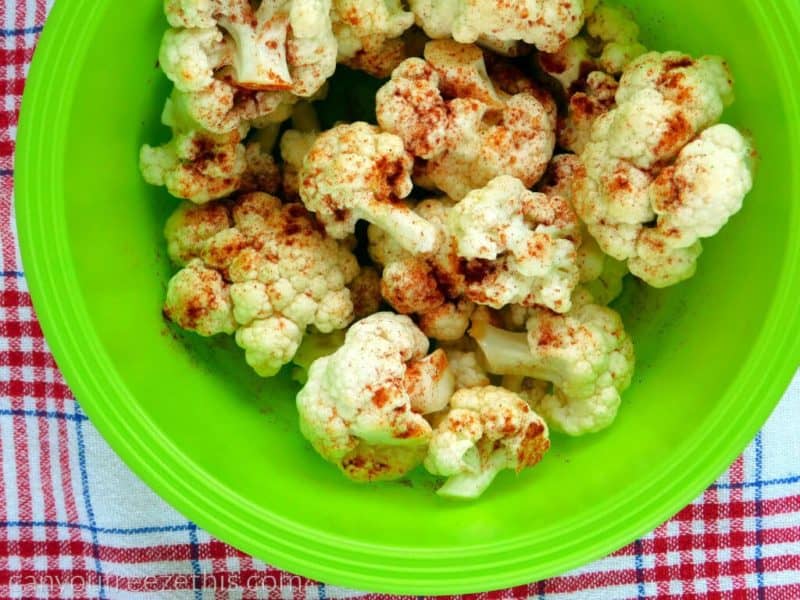
Mixing cauliflower with paprika and olive oil - Line up a cookie sheet with aluminum foil (for easy cleanup) and transfer the florets onto the sheet. Spread the cauliflower florets evenly so they form a single layer (i.e. no florets on top of other florets). Florets sticking to one another isn’t an issue at all.
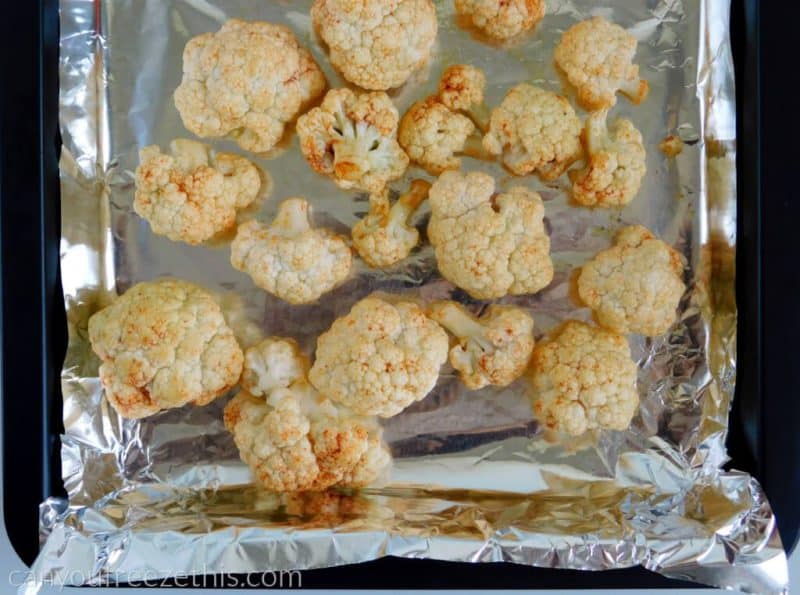
Cauliflower florets before roasting - Put the cookie sheet into the oven once it reaches the ideal temperature and bake the florets for about 25 minutes. Before taking the sheet out of the oven, make sure the florets are cooked well by piercing a few with a fork. Leave the veggies in the oven for an additional 5 minutes if needed.
- Take the cookie sheet out of the oven and let it sit in room temperature until the florets cool down.
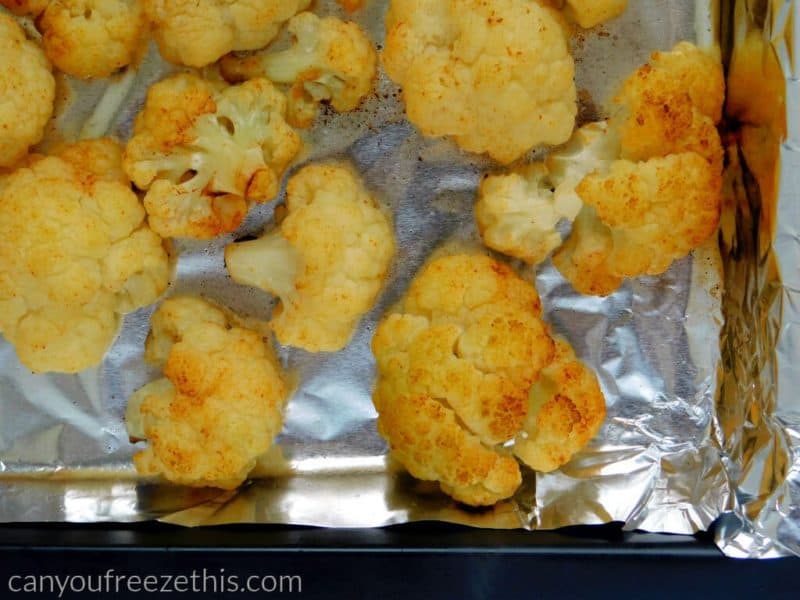
Roasted cauliflower - Transfer the florets into freezer bags, freezer containers or meal-prep containers. If you are using bags, remove as much air out before sealing it.
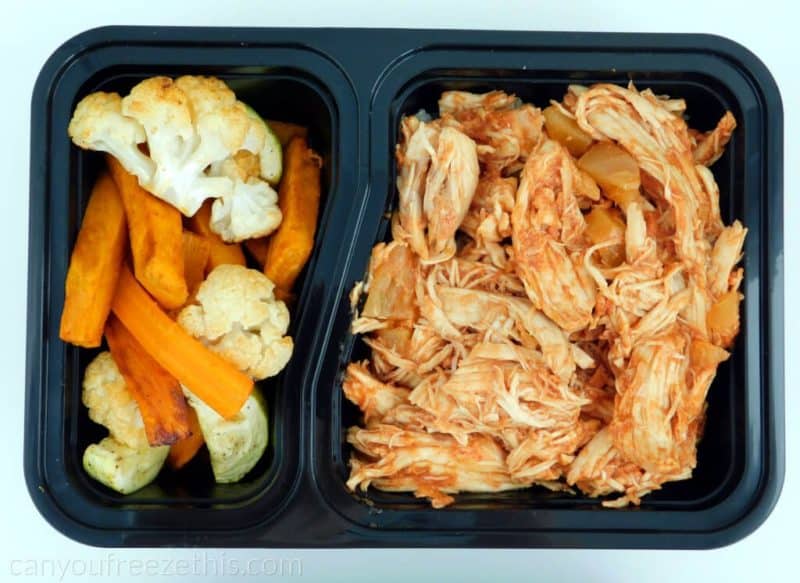
Meal prep container with roasted cauliflower - Label the bags or containers if needed.
- Chuck the veggies into the freezer.
How to Defrost Frozen Cauliflower
You can go about defrosting cauliflower florets in a few ways:
- Throw it directly into the meal you’re cooking. If it’s a cooked meal like a soup or a stew, you can just throw in the frozen florets. The frozen cauliflower florets will thaw as the dish cooks. Make sure to add a few minutes to the cooking time to account for defrosting and warming up of the cauliflower.
- Defrost overnight in the fridge. This is the most popular method of defrosting frozen food in general. Just transfer the frozen florets into the fridge the night before you need it and voila, the vegetable is defrosted in the morning.
- Use a frying pan. I routinely reheat my frozen meals on a frying pan. If you’re working with frozen food, start off on low heat until it defrosts. Once the food defrosts, there will be some water on the pan and you can turn up the heat a bit to warm it up. Defrosting and reheating on a frying pan is perfect if you’ve baked the florets. If you’ve just blanched them, you need to cook them before eating. That will take much more time and might require some oil like olive oil so the veggies won’t burn in the pan.
About the Author

Marcin is the managing editor of CanYouFreezeThis.com. He is making sure all the freezing info on this page is accurate and the posts easy to digest and use.